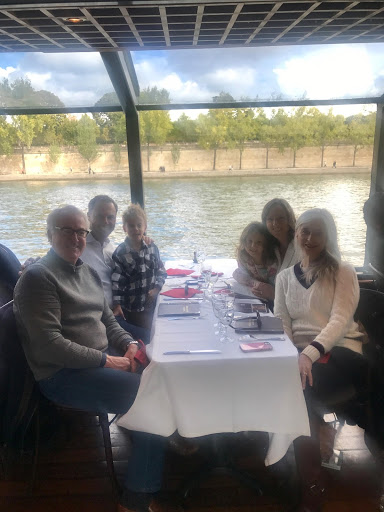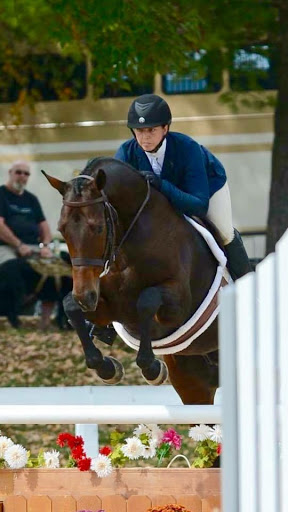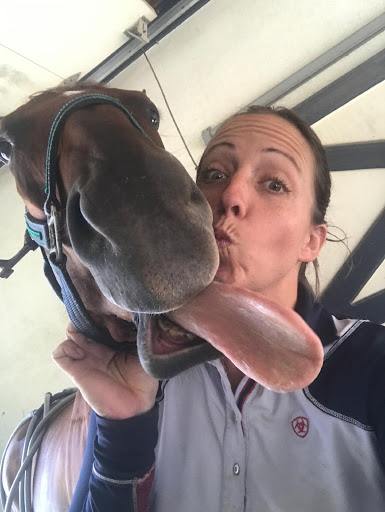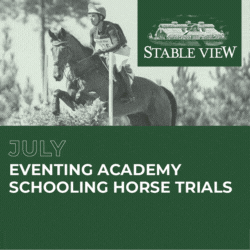For 673 accepted trainers, the 2019 Retired Racehorse Project Thoroughbred Makeover is fast approaching! From the beginning of the year until the Makeover, to take place Oct. 2-5 at the Kentucky Horse Park, four of those trainers have been blogging their journeys, including their triumphs and their heartbreaks, successes and failures, for Eventing Nation readers. Read more from EN’s 2019 Thoroughbred Makeover Bloggers: Lindsey Burns, Hillary McMichael, Clare Mansmann, Jennifer Reisenbichler.
Art is funny. Be it paint or pencil, photography or writing, no styles are the same, some compliment others better, and one person can swoon over a piece while someone else cocks their head in disbelief. That’s the beauty in the world, even in the small world of equestrianism.
When I was about 13 years old, I haughtily told my father that there was an art to cleaning stalls, and he still teases me about it, and I STILL retort that there IS an art to cleaning stalls, and he does it wrong. And I’m right.
If there is art to picking up poo, then there is certainly art to training horses, and so we can jump to discussing the forms of art involved in preparing a horse (or six) for the Thoroughbred Makeover. This is how my mind works. My husband is a lucky, lucky man…
Anyway, for this, the fourth year of our Makeover, we are more prepared than ever(ish). Or, shall I say, our horses are more prepared. I, personally, still can’t find safety pins and I buy two new hair nets for every single show.
Believe it or not, this isn’t a humble brag post, I promise (was it ever?). This is the voice of experience. Our first Makeover, we took a horse that we acquired on the last possible day, had truck trouble and blew three tires en route, showed up basically a day late, missing the Field Hunter division, skating into a scratched slot in the Eventing division (and, ahem, wound up tenth, because OTTBs are amazing and horses look at Tom and yell, “Okay!!”).
Year two, our horse was very well-schooled in eventing and jumpers, but we always knew his wheelhouse was show hunters. He was phenomenal at the Makeover, but probably if the Makeover wasn’t his first hunter show, that would have been cool. But you know us event riders—we’re gonna get around a course.
Year three, our horses were even better. Two had been able to compete and hunt, one was still quite green and one just went for the experience. What we had not been able to do prior to the Makeover was off-site stabling and competition, and so, quite honestly, we weren’t prepared for the preparation needed when we arrived in Kentucky. As an example, we mainly ride in the mornings at home. I turn into a pumpkin at 2pm, but I’ll get up at 4am happy as can be. When I hopped on Buff Dude at 4pm for a school in the coliseum, I had an uncharacteristic dragon. Long story short, I learned that you do nothing with Dude without feeding him first (and I do not mean just free choice hay—that doesn’t count). And I mean nothing. You let him eat, or you have hangry Dude, and when you ride a horse who could deploy your air vest over a cross rail, you only ride them happy, not hangry.
It could be easy to blame anyone but ourselves for any part of the above. We could blame the horse, their feet, their earlier training, their breeding, racing, the Makeover competition itself, the time frame, where we live, wherever we got the old trailer that also blew a tire on the way home on year 1 (okay, I can’t give them all the blame but I’m okay with passing a little on there). The truth is, the training and preparation of the horse is our responsibility. We need to make the best decisions for each horse, as each horse will require a different plan. This is not to say that every plan should include the Makeover competition, but if you’ve done your homework, you should know pretty early on if the “if” is capitalized for your horse (but maybe with a soft maybe), or if it’s just a plain old hard no, and that’s okay.
As equine professionals, we assume that role on behalf of our equine partners quite seriously, but we also have a great responsibility to our clients (the two-legged kind). We have a phenomenal clientele, quite by design, and this year has brought some of them into the RRP family. Helping to get horses ready for the Makeover for others, rather than just for ourselves, has truly upped our preparation. Tom may be able to swing a top ten finish in ranch with little prior competition experience in that division (*insert eye roll*), and I may be able to finish a 3’ show round pretty happily for the first time out, and we both should be able to canter around a cross country course and finish a horse trial pretty respectably. We are not against using a large show as a schooling opportunity, but we want our clients to do better, to feel better, and to have even more fun.
In a recent interview with Retired Racehorse Radio, I was asked for some of my top advice for at the Makeover, and I rambled on because I have SO MUCH ADVICE! (You can listen to the podcast for August 25th.) After actually thinking about it, I have compiled a bit of a list, so here goes. The top ten. Until I think of more…
1- Field trips. The RRP made the hashtag of #fieldtripfriday and we were on board before it was even official. When training opened in December, for the horses who were with us, we had them all over the place. Okay mainly indoors. Fortunately our loving relationship with Ashland Equestrian and Beverly Equestrian allowed us ample opportunity to work our horses through the winter in “competitive” environments.
As the weather warmed, we still took advantage of our friends and neighbors (don’t worry, we reciprocated as best we could), but we also kept pushing it. We went to Loch Moy several times. We shipped at least twice per month to our friend, Natalie Wales’ place to ride with Jimmy Wofford, we went to schooling shows, recognized shows, got up at 4am to go to Overlook’s fabulous show jump schools. We had the opportunity to perform demos at the VA Horse Festival in Doswell, VA, allowing us to practice stabling overnight.
We went down to Lexington, VA for the House Mountain Shows and had an amazing time during the week. We went BACK to Lexington (VA) for the Thoroughbred Heritage Show with even better horses (same horses, they were just even better). The Virginia Horse Center there is the perfect prep for the Makeover, with indoors and covered and cross country and outdoors and hunters and jumpers and dressage and if you time it right, BARREL RACING!! Epic.
2- Farrier. Good gracious, get a good farrier. Get two. Maybe three. Your horse needs it, even if you don’t realize it. Do some studying on hoof conformation, internal and external. Learn about what a balanced hoof looks like. Realize that it can take time, but that also that time can really pay off, and a horse with kinda not so great feet can turn out to have pretty darn good feet. Don’t be scared of glue. Don’t be scared of the progression. Don’t be scared to ask questions, and if you are, then don’t be scared to figure out why. No hoof, no horse, is real.
3- “Help, help! Who can help?!” So…this is from a children’s book and I can’t even say the word “help” without repeating the lines. If you aren’t like me (“one duck, stuck in the muck”), aka normal, then just, go with it. Training a horse isn’t an individual sport. I feel amazing frequently until I watch a video of myself or have Amanda Cousins *gently* say, “Why are you going so slow?” We need trainers and ground people who help us pull our heads out of our keisters so we can sit back, keep our feet underneath ourselves, and stop picking at the reins, for our horse’s sakes.
4- Different riders. When I wrote some questionable OTTB dating articles for Horse Nation, I maybe mentioned that when searching for your new partner, you shouldn’t be afraid to date others. I’m not 100% certain that my analogy transfers precisely, but still, one rider on one horse is truly never a great plan.
Having someone else, whether they be a professional, a good riding amateur, or even a student or friend, can be a game changer. Not only can you learn a lot about a horse by watching someone else on them, but you can learn a lot about your own riding and its effect. Find their holes, your holes, and how you can build a team to fill them.
5- Training jumping horses like working hunters. I bet there are a few of us who are tired of seeing the “this horse is NOT a ______” said with all assurance in the first year of their training. Now, there’s no reason you can’t speculate in the positive, as in “this horse has the form for the hunters”, or “this is a super brave horse for XC”, and the like. But there is no reason to put limits on any horse, outside of an actual physical limitation for safety. Our limitations are our own.
Trained properly, an OTTB should be able to go in any ring you enjoy in the lower levels. Sure, some naturally have better form than others, but that doesn’t mean a whole lot to me. Form can be taught and improved through flatwork (DRESSAGE), groundwork, and gymnastics. If a horse jumps a cross rail in perfect form, I tend to worry about their scope over a larger fence (though, if your goals are 3’ and under, you go get that horse STAT—they are valuable). If they push so hard behind that they overpower and jump over their front end, I tend to take notice.
As they continue in their first year and into their second, we want to see them canter down to the base of the jump with a loop in the rein, in a balanced canter. Not picked to the base by the show jumper, not gunned for the long by the eventer, and not leaned to the weak, long by the show hunter (you know who you are—shoot, sometimes we’re all three in one day). From there, you can begin to specialize because the horse (and the rider) has the right foundation to build on.
Don’t be scared of taking your hunter into the jumper ring and vice versa. Go on with your bad self in the dressage arena; twenty meter circles and the ability to do transitions make for a good over fences course! And get your buns outside of the arena! Jump some logs, walk through water, gallop up a hill (okay, this is EN…I’ll assume this isn’t revolutionary, but still!!).
6- Leave your ego. Show your horse. Step back and note the progression. Not the progression compared to anyone or anything else, but the actual progression of the horse. Don’t count days. Pay attention to the details, but marvel at the big picture on the regular.
7- Goals are great and we totally recommend them, but something to consider is how to shape that goal. The Makeover is not the end game or the ultimate goal, but a short-term one. And maybe the goal shouldn’t be to compete at the Makeover, but to prepare for it, to train for it. Rather than putting all the pressure on a few days, let the Makeover be an outlet for the work you’ve put in, something to help you stay on track, and also a test against which you may find that training is enough, and competing isn’t the right decision. Or that going for the experience and awesome camaraderie is the point and that being competitive falls by the wayside.
8- Train your horse like it’s for sale. Train like it’s for someone else. I always kinda/sorta jokingly recommend that when someone buys a green horse, especially with a particular discipline in mind, consider spending that first year pretending the horse is for sale. With that perspective, we tend to create a more well-rounded horse. We get to know them without feeling the pressure of a long-term commitment and allow them to tell us (or perhaps we just listen better) when we don’t put our own expectations on them. At the end of that year(ish), decide if you want to buy your own horse!

Speaking of art, how stunning are these?? Hill’s mane was down to his shoulder, and Alyssa Shelton from Blue Ribbon Braiding worked magic. And yes, she is hired again. And again and again.
9- Here’s a big one. Hire a braider. I used to resist. I’m a good braider and I don’t want to pay for anything not better than mine. We’ve all been burned and it’s like the worst thing most first world problem in the world. It’s also an ego problem. I don’t want anyone to think I did a bad braid job, or that I think a bad braid job is a good braid job, or for our clients to have a bad braid job, and really it’s just clearly very stressful.
So, over the course of several Makeovers, there I was, in the dark, after riding for hours along with trying to care for our tolerant children, braiding like an idiot, with the exception of hiring out hunter braids (you people are ninjas). Here’s the thing: in Lexington, KY, at the Makeover, there is a collection of some of the most talented braiders I’ve ever seen. Hire them. Pay them.

I don’t know why more people don’t get married on a beach in France. I also don’t know why more grandparents don’t go to France to babysit children for said wedding…
10- And finally, Go. On. Vacation! No seriously. It started by accident, or by friends getting married in France just before the Makeover a few years ago and who says no to that?! Probably plenty of people but we are not them. It has become a trend that our summers are busy, and they aren’t just busy drilling our horses. Eventers work hard and party hard; that’s always been a thing.
With maturity, the partying has probably changed a bit (particularly as I enjoy being in bed by 9pm). But we take time. We see family and we take days off. We go away for our anniversary, or maybe we’ll stay close to home, but I promise we’re not out practicing our wtc circles when we should be celebrating 12 years of marriage that should certainly be celebrated.
These horses don’t need to fitness of an old format 4* horse. Give them a break, give yourself a break, and see how well you both come back.
The point is, don’t take all this stuff too seriously. The world has enough troubles of its own. Have a plan, keep it open. Work hard, but only when you’re working. As Mickey says, “There is no right and wrong, when it comes to making art. Making sure that you have fun is the most important part.” If you have children, you know exactly how this sounds in my head.
Otherwise, get a T-Rex. Better yet, get two! (They’re herd animals.)

























